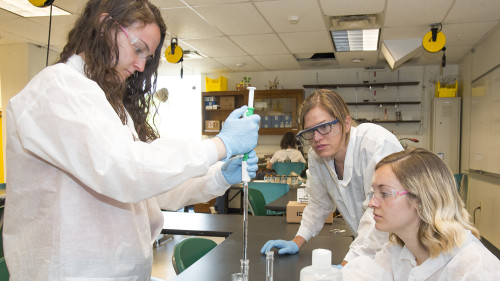
Biology students at Siena now have a pair of new compound fluorescence light microscopes to use both in class and independent research based lab activities.
Thanks to a $125,000 grant from the George I. Alden Trust, the College has purchased two new Leica DM2000 compound fluorescence microscopes. These are the first two microscopy devices in what eventually will be a completely outfitted advanced imaging center.
The new microscopes will be used for student lab work and faculty research in cell biology, neurobiology, developmental biology and microbiology, according to Adam Mason, Ph.D, associate professor of biology. They were installed in December, and students have already had their first lab experiences with them.
“These are excellent advanced teaching tools to have in our lab,” said Mason. “We’ll be able to create really high-quality, beautiful images and give students the opportunity to observe cell biological processes in action. Students will get hands-on practice using research quality scopes rather than just watching a demonstration. It is rare for undergraduate colleges to provide students with the opportunity to use this type of equipment in a class-based laboratory setting.”
Fluorescent microscopy is one of the most commonly used techniques in the fields of molecular cell and developmental biology due to its high sensitivity and high specificity, according to Mason. It is a form of luminescence that allows users to determine the distribution of a single molecule species, its amount and its localization inside a cell, among many other functions.
Currently located in Morrell Science Center 111, Siena’s advanced imaging center will eventually be housed in the new Nobel Hall. Long range plans include the purchase of two more compound fluorescence light microscopes, as well as the addition of two dissecting microscopes and a rare confocal microscope for optical sectioning.
Cherisse Young, director of foundation and corporate grants, said once Siena’s advanced imaging center is fully outfitted with the seven microscopes, it will allow students to see things with their own eyes they previously have seen only in textbooks.
“Siena students and faculty can perform cutting-edge experiments and procedures similar to those conducted in the top research labs around the world,” she said. “This will provide meaningful training and make our graduates more competitive for positions in top biology labs as well as top-tier graduate programs in biomedical and biological science.”
The Leica model is built to withstand heavy use by multiple students and does not require extensive training. Maria Fitian ’23 said using the scopes enables her and her classmates to visualize cell growths and developments, such as the C. elegans in their most recent lab.
“This takes the learning experience to a different level because it motivates us to understand what we’re looking at and keeps us in good lab practices,” said Fitian. “This is a huge step for not only Siena’s classroom learning, but also for expanding research.”
She said scopes have come a long way from the fuzzy black and white images in old textbooks.
“Now we're looking at such crisp visuals of what’s going on at a scale that’s so small, it’s just unreal to think about. I’m very grateful to be able to get to work with this kind of technology, and for the possibilities that are just waiting ahead.”
Ragy Beshay ’23 said once students learn to use the new scopes, they’ll get “a greater appreciation of the magnificence of creation and development.”
“Having top equipment like this at an undergraduate level makes students confident in choosing Siena as a place to be an excelling scientist,” Beshay said.
Colleen Malone ’24 is thinking of pursuing a career in cytotechnology, and is grateful for the opportunity to observe and understand how development works.
“Becoming an expert on using various types of microscopes will come handy for students like me in the future,” she said.

